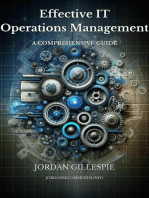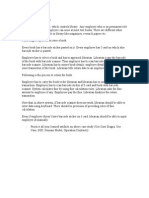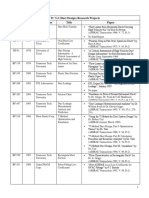0 ratings0% found this document useful (0 votes)
112 viewsIt Process Automation Survival Guide
Document on ITIL process automation. Explain on IT process Automation survival.
Uploaded by
cpawan_699508Copyright
© © All Rights Reserved
Available Formats
Download as PDF, TXT or read online on Scribd
0 ratings0% found this document useful (0 votes)
112 viewsIt Process Automation Survival Guide
Document on ITIL process automation. Explain on IT process Automation survival.
Uploaded by
cpawan_699508Copyright
© © All Rights Reserved
Available Formats
Download as PDF, TXT or read online on Scribd
You are on page 1/ 29
By Gabby Nizri
2012 Ayehu Software Technologies Ltd. All rights reserved.
IT Process Automation
Your Survival Guide!
Tweet This Guide Share on Facebook Share on LinkedIn
Whats in it for You?
The biggest misconception about IT Process
Automation (ITPA) is that its incredibly
expensive and complex. This eBook dispels
that notion and answers many of the common
questions, such as:
2
How to begin the automation?
Which processes should be automated?
How to calculate ROI?
How to evaluate ITPA tools?
What are the key success factors?
Tweet This Guide Share on Facebook Share on LinkedIn
Table of Contents
What is IT process automation? 4
What does ITPA include? 5
Why IT process automation? 6
Automation categories 8
Most important areas to automate 10
Scripting or ITPA tools? 12
Planning for IT process automation 14
Visually modeling your processes 16
Calculating ROI 17
How to evaluate ITPA tools 20
Two customer success stories 23
Ingredients for success 28
Summary ingredients for success 30
3
Tweet This Guide Share on Facebook Share on LinkedIn
IT Process Automation (ITPA), also known as Run Book Automation
(RBA) is designed to automate system and network operational
processes, while interacting with infrastructure elements such as
applications, databases and hardware.
Used within data centers and Network Operation Centers (NOCs), ITPA
is driven by the need for higher IT operational efficiency , better
provisioning of IT services and reduction of Mean Time to Repair
(MTTR).
ITPA also helps optimize the delivery and management of cloud
computing and virtualized data centers.
What is IT Process Automation?
4
Tweet This Guide Share on Facebook Share on LinkedIn
What does ITPA include?
5
Automation addresses a wide range of
issues:
ITIL incidents
Cloud management
App and service provisioning
Problem remediation
Maintenance and task automation
Tweet This Guide Share on Facebook Share on LinkedIn
Why IT Process Automation?
IT Process Automation delivers
quantifiable, bottom-line results.
1. Free up resources by allowing your
staff to focus on strategic IT initiatives
instead of spending time on repetitive,
time-consuming tasks.
2. Reduce resolution time by 50-90%
with faster response to critical IT
events, particularly during off-duty
hours.
6
IT automation is no
longer an add-on
technology it is
quickly becoming the
way IT must look to
manage its
infrastructure.
IT automation is no
longer an add-on
technology it is
quickly becoming the
way IT must look to
manage its
infrastructure.
Tweet This Guide Share on Facebook Share on LinkedIn
Why IT Process Automation?
3. Improve service quality up to 70% by taking actions
automatically in response to user requests.
4. Achieve 100% compliance to regulatory requirements with
automatic documentation and events trace-back.
5. Enforce IT standards by triggering pre-defined procedures
and escalations.
7
Tweet This Guide Share on Facebook Share on LinkedIn
Automation Categories
Process candidates for automation
can be roughly categorized into two categories:
1. Operational processes (also called data center processes),
which have a stronger focus on operational IT systems and
procedures for example, backup & recovery, access
management, etc.
2. Business processes, which span across systems and involve
user activities.
Tweet This Guide Share on Facebook Share on LinkedIn
Automation Categories
9
The line between these two types of
processes is not clear cut. In many cases a
process may be both operational and
business oriented.
The InformationWeek survey results seem
to indicate that the majority of processes
automated are either operational or
processes that are combined.
A combination of
operational &
business processes
Business &
customer processes
Operational
& data center
processes
Dont
know
Source: InformationWeek
2011 IT Process Automation
Survey
Tweet This Guide Share on Facebook Share on LinkedIn
What are the Most Important Areas
to Automate?
10
The InformationWeek
survey looked for the
answers what users think
are the most important
areas for automation (on a
scale of 1 to 5).
?
Tweet This Guide Share on Facebook Share on LinkedIn
Most Important Areas to Automate
11
Unlike the respondents, the
researchers identified other
key win areas that could
provide more value.
These include:
Change management
Configuration management
Provisioning
Routine maintenance
Identity & access management
Source: InformationWeek 2011 IT Process Automation Survey
Tweet This Guide Share on Facebook Share on LinkedIn
Scripting Vs. ITPA Tools
12
Many IT organizations use scripting to automate tasks. This may work
well for well-defined tasks, such as provisioning a server.
Yet scripting has its drawbacks, particularly for more complex IT
workflows that cross processes and domains.
With scripting, the lack of built-in integration with IT management and
orchestration systems reduces your flexibility and ability to manage the
processes end-to-end from triggering or scheduling and up to closing
tickets.
Tweet This Guide Share on Facebook Share on LinkedIn
Scripting Vs. ITPA Tools
13
Another problem with scripting is your ability to
keep an audit trail, review and analyze events.
Scripts are reusable if all the elements
are standard. This, however, is almost
never the case.
You should also consider
the issue of knowledge
management and your
ability to maintain and
keep scripts updated
over time, as employees
with operational
knowledge leave.
As IT processes change
and scripts need to be
modified, your simple
home-grown scripts can
become a full-time
programming commitment.
Tweet This Guide Share on Facebook Share on LinkedIn
Planning for IT Process Automation
14
Before you jump into evaluating
ITPA tools, it is well worth to plan
your time ahead.
Define KPIs for success.
Define what would be your
baseline metrics for success:
Hours saved? Number of
processes automated? A
service response metric?
Tweet This Guide Share on Facebook Share on LinkedIn
Planning for IT Process Automation
15
Know your processes. Conduct a
thorough system/process analysis,
where you document your existing
processes and systems, including
interfaces, integration points, and input
& output formats. It may seem a waste
of time (you already know everything
about your processes), but automation
needs to handle many semiformal
steps that humans perform.
Decide which processes to
automate. You dont have to
automate all your IT
processes. Identify quick
wins you can start with
processes that will deliver the
most value if automated and
those that require a small
effort to automate. See
Calculating ROI.
Tweet This Guide Share on Facebook Share on LinkedIn
Visually Model your Processes
16
By visually modeling a process,
you are able to focus on its logical
elements and flow, before getting
wrapped up in technical details.
You can identify the exact
sequence of steps, define inputs
and outputs, logic branching, and
think about any human decision
points that need to be incorporated
within the flow.
Tweet This Guide Share on Facebook Share on LinkedIn
Calculating ROI
17
Return on investment for ITPA can be addressed at two levels on the
macro level, the total ROI for implementing ITPA ( tool, training etc.), and
on the micro level, calculating the ROI for each individual process you
automate.
ITPA total ROI
On the tools side, you should take into account both tool costs and the
effort required to integrate the tool into your environment and develop
workflows. Some ITPA capabilities are embedded inside larger suites,
which require heavier costs, whereas other vendors provide dedicated
and usually cheaper tools.
Tweet This Guide Share on Facebook Share on LinkedIn
Calculating ROI
18
To evaluate the cost of generating automated workflows, you should
consider several functional capabilities, such as a visual workflow designer
that eliminates the need for scripting, the provision of templates with pre-
canned content, and the integration with external systems.
Bottom line you should not skip a POC and try to get from vendors
a feel for the duration & cost of automating your specific processes.
Though its difficult to generalize, the ROI on an ITPA solution that
should not exceed 9 months.
Tweet This Guide Share on Facebook Share on LinkedIn
Calculating ROI
19
Individual Process ROI
To evaluate the ROI of an individual process, begin with calculating
the current time of the manual task. For example, a task that takes
one hour of an administrators time, one hour of a manager, and is
performed twice a week, can be evaluated at 16 monthly hours. If it
takes 8 hours to automate the task, then your ROI for that process
will be two weeks.
Tweet This Guide Share on Facebook Share on LinkedIn
7 Questions to ask when evaluating
ITPA tools
20
1. Integration points. Verify that the tool can easily have touch points
and triggers with your data center systems, including different OS, legacy
systems, help desk, management systems, etc.
2. Deployment effort. Evaluate how much time and effort will be
required for deployment setup, configuration, etc.
3. Required skill set. What is the estimated learning curve for
generating workflows independently, on your own?
Is scripting required?
Tweet This Guide Share on Facebook Share on LinkedIn
7 Questions to ask when evaluating
ITPA tools
21
4. Out-of-the-box functionality. Does the tool provide pre-canned
templates for various tasks, which can easily be tailored to fit your
environment and process?
5. Human intervention. Even the simplest automated processes will
require human decision. Can you embed decision-making logic in
workflows for remote automatic decisions on process execution?
Tweet This Guide Share on Facebook Share on LinkedIn
7 Questions to ask when evaluating
ITPA tools
22
6. Scheduling. While some automated processes will be triggered
by system events, others (such as repetitive tasks) will need to be
scheduled.
7. Regulatory compliance. Does the tool provide tracking of events,
reports and knowledge management that can help you? comply to
regulations?
Tweet This Guide Share on Facebook Share on LinkedIn
At the end of the day, what matters the
most is the bottom line. So, what type of
benefits can you expect to gain with IT
process automation?
Here are two great examples that
demonstrate how two different IT groups
automated their processes and the
change they have experienced.
Two Customer Success stories
23
Tweet This Guide Share on Facebook Share on LinkedIn
Large Bank Success Story
24
Company: Large banking group with over
250 branches, 3,000+ servers, and hundreds
of mission-critical online applications.
Challenge: Manual processes consumed
significant IT time. Slow response to critical
events during off-duty hours & weekends.
Tweet This Guide Share on Facebook Share on LinkedIn
Large Bank Success Story
25
Results: Automated processes integrated with
multiple IT systems (Patrol, Siebel, MQ, TSM,
Telephony..).
430 hours of manual work eliminated on a monthly
basis, Response time to critical system failures
reduced from 15 minutes to seconds .
Tweet This Guide Share on Facebook Share on LinkedIn
Insurance Company Success Story
26
Company: Leading insurance, pension, and financial
services group.
Challenge: Frequent failures of financial web portal serving
thousands of agents, Slow recovery leading to lost of business.
Results: Automated alerts, escalations and incident ownership.
Portal recovery time cut by 90%.
Tweet This Guide Share on Facebook Share on LinkedIn
4 Ingredients for success
27
1. Start small
Dont jump into large-scale automation projects. Instead, aim
for quick wins - small, targeted projects that will deliver
immediate results. For example, repetitive tasks such as
freeing up disk space, or other file management operations.
2. Know your processes
Before you get wrapped up in technical details, you must
document your manual processes workflows. which processes
should you automate?
Tweet This Guide Share on Facebook Share on LinkedIn
4 Ingredients for success
28
3. Think wide
Though youll begin with small-scale projects, you want to
ensure you can expand your automation in a modular fashion
and apply automation to processes that cross domains (server,
storage, network), such as proactive maintenance tasks.
4. Prepare your team
Prepare your team for automation. Set roles and functions so the
IT group is trained and ready to adapt to new processes and
models.
Tweet This Guide Share on Facebook Share on LinkedIn
29
Get Started with IT Process Automation
Download Ayehu eyeShare 30 Day Free Trial
You might also like
- Auditing Information Systems: Enhancing Performance of the EnterpriseFrom EverandAuditing Information Systems: Enhancing Performance of the EnterpriseNo ratings yet
- Measuring Itsm: Measuring, Reporting, and Modeling the It Service Management Metrics That Matter Most to It Senior ExecutivesFrom EverandMeasuring Itsm: Measuring, Reporting, and Modeling the It Service Management Metrics That Matter Most to It Senior ExecutivesNo ratings yet
- Practical IT Service Management: A concise guide for busy executivesFrom EverandPractical IT Service Management: A concise guide for busy executivesNo ratings yet
- Enterprise Resource Planning (Erp) the Great Gamble: An Executive’S Guide to Understanding an Erp ProjectFrom EverandEnterprise Resource Planning (Erp) the Great Gamble: An Executive’S Guide to Understanding an Erp Project4.5/5 (5)
- High Velocity Itsm: Agile It Service Management for Rapid Change in a World of Devops, Lean It and Cloud ComputingFrom EverandHigh Velocity Itsm: Agile It Service Management for Rapid Change in a World of Devops, Lean It and Cloud ComputingNo ratings yet
- It Project Management – Explained: For Software DevelopersFrom EverandIt Project Management – Explained: For Software DevelopersNo ratings yet
- Anticipate Industry Disruption Take Your IT to the Next LevelFrom EverandAnticipate Industry Disruption Take Your IT to the Next LevelNo ratings yet
- Learn Python: Get Started Now with Our Beginner’s Guide to Coding, Programming, and Understanding Artificial Intelligence in the Fastest-Growing Machine Learning LanguageFrom EverandLearn Python: Get Started Now with Our Beginner’s Guide to Coding, Programming, and Understanding Artificial Intelligence in the Fastest-Growing Machine Learning Language5/5 (3)
- Smarter, Not Harder: Using AI to Supercharge Your ProductivityFrom EverandSmarter, Not Harder: Using AI to Supercharge Your ProductivityNo ratings yet
- Operating AI: Bridging the Gap Between Technology and BusinessFrom EverandOperating AI: Bridging the Gap Between Technology and BusinessNo ratings yet
- Application and Technology Rationalization: A Strategic Guide for Midsize to Large Companies: IT and Digital TransformationFrom EverandApplication and Technology Rationalization: A Strategic Guide for Midsize to Large Companies: IT and Digital TransformationNo ratings yet
- IT4IT™ for Managing the Business of IT - A Management GuideFrom EverandIT4IT™ for Managing the Business of IT - A Management GuideNo ratings yet
- Strategy Guide for Automation: Scale your business with IT automation (English Edition)From EverandStrategy Guide for Automation: Scale your business with IT automation (English Edition)No ratings yet
- Enterprise Architecture for Digital Transformation: Aligning IT Strategy with Business GoalsFrom EverandEnterprise Architecture for Digital Transformation: Aligning IT Strategy with Business GoalsNo ratings yet
- Organizing Itsm: Transitioning the It Organization from Silos to Services with Practical Organizational ChangeFrom EverandOrganizing Itsm: Transitioning the It Organization from Silos to Services with Practical Organizational ChangeNo ratings yet
- Building a Digital Future: A Transformational Blueprint for Innovating with Microsoft Dynamics 365From EverandBuilding a Digital Future: A Transformational Blueprint for Innovating with Microsoft Dynamics 365No ratings yet
- Successful Digital Transformation: A survival guide for managers and executivesFrom EverandSuccessful Digital Transformation: A survival guide for managers and executivesNo ratings yet
- The Mulesoft Handbook: Simplifying Enterprise Application ConnectivityFrom EverandThe Mulesoft Handbook: Simplifying Enterprise Application ConnectivityNo ratings yet
- 8 Things We Hate About IT: How to Move Beyond the Frustrations to Form a New Partnership with ITFrom Everand8 Things We Hate About IT: How to Move Beyond the Frustrations to Form a New Partnership with IT3/5 (3)
- AGILE PROJECT MANAGEMENT: Navigating Complexity with Efficiency and Adaptability (2023 Guide for Beginners)From EverandAGILE PROJECT MANAGEMENT: Navigating Complexity with Efficiency and Adaptability (2023 Guide for Beginners)No ratings yet
- Implementing Itsm: From Silos to Services: Transforming the It Organization to an It Service Management Valued PartnerFrom EverandImplementing Itsm: From Silos to Services: Transforming the It Organization to an It Service Management Valued PartnerNo ratings yet
- Comprehensive Guide to Robotic Process Automation (RPA): Tips, Recommendations, and Strategies for SuccessFrom EverandComprehensive Guide to Robotic Process Automation (RPA): Tips, Recommendations, and Strategies for SuccessNo ratings yet
- Data Entry Operator: Skills, Software, Career Tips, and Interview Q&AFrom EverandData Entry Operator: Skills, Software, Career Tips, and Interview Q&ANo ratings yet
- Book Series: Increasing Productivity of Software Development, Part 1: Productivity and Performance Measurement - Measurability and MethodsFrom EverandBook Series: Increasing Productivity of Software Development, Part 1: Productivity and Performance Measurement - Measurability and MethodsNo ratings yet
- AI factory: AI IS A MANAGEMENT CHALLENGE, NOT A TECHNOLOGY CHALLENGEFrom EverandAI factory: AI IS A MANAGEMENT CHALLENGE, NOT A TECHNOLOGY CHALLENGENo ratings yet
- AI Tools for Entrepreneurs: How to Automate Your Business and Save Hours Every Week: 1From EverandAI Tools for Entrepreneurs: How to Automate Your Business and Save Hours Every Week: 1No ratings yet
- Program Management in the Age of AI: Program Management in the Age of AI Vol 1, #1From EverandProgram Management in the Age of AI: Program Management in the Age of AI Vol 1, #1No ratings yet
- Avoiding Software Project Pitfalls: Seven Simple Ground Rules That Could Save Your CareerFrom EverandAvoiding Software Project Pitfalls: Seven Simple Ground Rules That Could Save Your Career4/5 (1)
- The Comprehensive Guide to RPA, IDP, and Workflow Automation: For Business Efficiency and Revenue GrowthFrom EverandThe Comprehensive Guide to RPA, IDP, and Workflow Automation: For Business Efficiency and Revenue GrowthNo ratings yet
- Work Less, Make More: Use the latest tech to simply work better, not harder by optimized work habits & efficient task breakdown, planning & execution to achieve the perfect work life balanceFrom EverandWork Less, Make More: Use the latest tech to simply work better, not harder by optimized work habits & efficient task breakdown, planning & execution to achieve the perfect work life balanceNo ratings yet
- Data & AI Imperative: Designing Strategies for Exponential GrowthFrom EverandData & AI Imperative: Designing Strategies for Exponential GrowthNo ratings yet
- Agile Leadership: A Leader’S Guide to Orchestrating Agile Strategy, Product Quality and It GovernanceFrom EverandAgile Leadership: A Leader’S Guide to Orchestrating Agile Strategy, Product Quality and It GovernanceNo ratings yet
- CBSE Class 11 Informatics Practices Sample Paper-03 (Solved)78% (27)CBSE Class 11 Informatics Practices Sample Paper-03 (Solved)13 pages
- UNIT-I - ECONOMY & CENTRAL PROBLEM Powerpoint Presentation (Repaired)100% (4)UNIT-I - ECONOMY & CENTRAL PROBLEM Powerpoint Presentation (Repaired)75 pages
- Solution of Question Paper For Class 12 EconomicsNo ratings yetSolution of Question Paper For Class 12 Economics5 pages
- Graduation Sem Vi - Database Management System Case Study For BusinessNo ratings yetGraduation Sem Vi - Database Management System Case Study For Business18 pages
- Industry 4.0 in Human Resource ManagementNo ratings yetIndustry 4.0 in Human Resource Management7 pages
- SAP For Engineering, Construction & Operations: Industry Briefing BookNo ratings yetSAP For Engineering, Construction & Operations: Industry Briefing Book56 pages
- HVAC Calculation Control Bldg. (System-01)No ratings yetHVAC Calculation Control Bldg. (System-01)21 pages
- Whitepaper Industrial Security Based On IEC 62443No ratings yetWhitepaper Industrial Security Based On IEC 6244332 pages
- Ensto Network Automation: Ensto Remote Control Line Switch (Auguste) and Its Advanced 2020 RTUNo ratings yetEnsto Network Automation: Ensto Remote Control Line Switch (Auguste) and Its Advanced 2020 RTU25 pages
- Application of Lean Manufacturing Tools and ICT To Increase Productivity LevelsNo ratings yetApplication of Lean Manufacturing Tools and ICT To Increase Productivity Levels8 pages
- Savitribai Phule Pune University: Timetable For Fresh & Backlog Online Examination of October/November 2020No ratings yetSavitribai Phule Pune University: Timetable For Fresh & Backlog Online Examination of October/November 20205 pages
- Automation in Manufacturing 10ME757: Department of Mechanical Engineering, SIRMVIT (Ramesh C G & Hanamantraygouda M B)No ratings yetAutomation in Manufacturing 10ME757: Department of Mechanical Engineering, SIRMVIT (Ramesh C G & Hanamantraygouda M B)193 pages
- Transforming B2B Marketing at Oracle With Oracle Cloud CX For MarketingNo ratings yetTransforming B2B Marketing at Oracle With Oracle Cloud CX For Marketing13 pages
- Tackling Preanalytical Challenges in Laboratory Automation - Dr. Tjian Sian HwaNo ratings yetTackling Preanalytical Challenges in Laboratory Automation - Dr. Tjian Sian Hwa43 pages
- Auditing Information Systems: Enhancing Performance of the EnterpriseFrom EverandAuditing Information Systems: Enhancing Performance of the Enterprise
- Measuring Itsm: Measuring, Reporting, and Modeling the It Service Management Metrics That Matter Most to It Senior ExecutivesFrom EverandMeasuring Itsm: Measuring, Reporting, and Modeling the It Service Management Metrics That Matter Most to It Senior Executives
- ITIL 4: High-velocity IT: Reference and study guideFrom EverandITIL 4: High-velocity IT: Reference and study guide
- ITIL 4: Digital and IT strategy: Reference and study guideFrom EverandITIL 4: Digital and IT strategy: Reference and study guide
- Practical IT Service Management: A concise guide for busy executivesFrom EverandPractical IT Service Management: A concise guide for busy executives
- Enterprise Resource Planning (Erp) the Great Gamble: An Executive’S Guide to Understanding an Erp ProjectFrom EverandEnterprise Resource Planning (Erp) the Great Gamble: An Executive’S Guide to Understanding an Erp Project
- High Velocity Itsm: Agile It Service Management for Rapid Change in a World of Devops, Lean It and Cloud ComputingFrom EverandHigh Velocity Itsm: Agile It Service Management for Rapid Change in a World of Devops, Lean It and Cloud Computing
- It Project Management – Explained: For Software DevelopersFrom EverandIt Project Management – Explained: For Software Developers
- Anticipate Industry Disruption Take Your IT to the Next LevelFrom EverandAnticipate Industry Disruption Take Your IT to the Next Level
- Achieving Excellence Optimizing IT Department KPIs for SuccessFrom EverandAchieving Excellence Optimizing IT Department KPIs for Success
- Learn Python: Get Started Now with Our Beginner’s Guide to Coding, Programming, and Understanding Artificial Intelligence in the Fastest-Growing Machine Learning LanguageFrom EverandLearn Python: Get Started Now with Our Beginner’s Guide to Coding, Programming, and Understanding Artificial Intelligence in the Fastest-Growing Machine Learning Language
- Smarter, Not Harder: Using AI to Supercharge Your ProductivityFrom EverandSmarter, Not Harder: Using AI to Supercharge Your Productivity
- ChatGPT : Revolutionizing Office ProductivityFrom EverandChatGPT : Revolutionizing Office Productivity
- Effective IT Operations Management: A Comprehensive GuideFrom EverandEffective IT Operations Management: A Comprehensive Guide
- How to Be a Successful Software Project ManagerFrom EverandHow to Be a Successful Software Project Manager
- Beyond Silos : The Integration Imperative for Modern ManagementFrom EverandBeyond Silos : The Integration Imperative for Modern Management
- Operating AI: Bridging the Gap Between Technology and BusinessFrom EverandOperating AI: Bridging the Gap Between Technology and Business
- Application and Technology Rationalization: A Strategic Guide for Midsize to Large Companies: IT and Digital TransformationFrom EverandApplication and Technology Rationalization: A Strategic Guide for Midsize to Large Companies: IT and Digital Transformation
- Navigating IT A Guide for the Non-Tech PersonnelFrom EverandNavigating IT A Guide for the Non-Tech Personnel
- IT4IT™ for Managing the Business of IT - A Management GuideFrom EverandIT4IT™ for Managing the Business of IT - A Management Guide
- Strategy Guide for Automation: Scale your business with IT automation (English Edition)From EverandStrategy Guide for Automation: Scale your business with IT automation (English Edition)
- Digital Productivity: Mastering Tools for SuccessFrom EverandDigital Productivity: Mastering Tools for Success
- Enterprise Architecture for Digital Transformation: Aligning IT Strategy with Business GoalsFrom EverandEnterprise Architecture for Digital Transformation: Aligning IT Strategy with Business Goals
- Organizing Itsm: Transitioning the It Organization from Silos to Services with Practical Organizational ChangeFrom EverandOrganizing Itsm: Transitioning the It Organization from Silos to Services with Practical Organizational Change
- Building a Digital Future: A Transformational Blueprint for Innovating with Microsoft Dynamics 365From EverandBuilding a Digital Future: A Transformational Blueprint for Innovating with Microsoft Dynamics 365
- Successful Digital Transformation: A survival guide for managers and executivesFrom EverandSuccessful Digital Transformation: A survival guide for managers and executives
- The Mulesoft Handbook: Simplifying Enterprise Application ConnectivityFrom EverandThe Mulesoft Handbook: Simplifying Enterprise Application Connectivity
- 8 Things We Hate About IT: How to Move Beyond the Frustrations to Form a New Partnership with ITFrom Everand8 Things We Hate About IT: How to Move Beyond the Frustrations to Form a New Partnership with IT
- AGILE PROJECT MANAGEMENT: Navigating Complexity with Efficiency and Adaptability (2023 Guide for Beginners)From EverandAGILE PROJECT MANAGEMENT: Navigating Complexity with Efficiency and Adaptability (2023 Guide for Beginners)
- Implementing Itsm: From Silos to Services: Transforming the It Organization to an It Service Management Valued PartnerFrom EverandImplementing Itsm: From Silos to Services: Transforming the It Organization to an It Service Management Valued Partner
- Comprehensive Guide to Robotic Process Automation (RPA): Tips, Recommendations, and Strategies for SuccessFrom EverandComprehensive Guide to Robotic Process Automation (RPA): Tips, Recommendations, and Strategies for Success
- Unlocking ChatGPT: Productivity Secrets for ProfessionalsFrom EverandUnlocking ChatGPT: Productivity Secrets for Professionals
- The Diligent Director in a Digital Business WorldFrom EverandThe Diligent Director in a Digital Business World
- Data Entry Operator: Skills, Software, Career Tips, and Interview Q&AFrom EverandData Entry Operator: Skills, Software, Career Tips, and Interview Q&A
- Book Series: Increasing Productivity of Software Development, Part 1: Productivity and Performance Measurement - Measurability and MethodsFrom EverandBook Series: Increasing Productivity of Software Development, Part 1: Productivity and Performance Measurement - Measurability and Methods
- AI factory: AI IS A MANAGEMENT CHALLENGE, NOT A TECHNOLOGY CHALLENGEFrom EverandAI factory: AI IS A MANAGEMENT CHALLENGE, NOT A TECHNOLOGY CHALLENGE
- Business Visibility with Enterprise Resource PlanningFrom EverandBusiness Visibility with Enterprise Resource Planning
- AI Tools for Entrepreneurs: How to Automate Your Business and Save Hours Every Week: 1From EverandAI Tools for Entrepreneurs: How to Automate Your Business and Save Hours Every Week: 1
- Program Management in the Age of AI: Program Management in the Age of AI Vol 1, #1From EverandProgram Management in the Age of AI: Program Management in the Age of AI Vol 1, #1
- Avoiding Software Project Pitfalls: Seven Simple Ground Rules That Could Save Your CareerFrom EverandAvoiding Software Project Pitfalls: Seven Simple Ground Rules That Could Save Your Career
- The Comprehensive Guide to RPA, IDP, and Workflow Automation: For Business Efficiency and Revenue GrowthFrom EverandThe Comprehensive Guide to RPA, IDP, and Workflow Automation: For Business Efficiency and Revenue Growth
- Business Dashboards: A Visual Catalog for Design and DeploymentFrom EverandBusiness Dashboards: A Visual Catalog for Design and Deployment
- IT GOVERNANCE APPROACHES FOR AGILE SOFTWARE DEVELOPMENT INVESTMENTSFrom EverandIT GOVERNANCE APPROACHES FOR AGILE SOFTWARE DEVELOPMENT INVESTMENTS
- Work Less, Make More: Use the latest tech to simply work better, not harder by optimized work habits & efficient task breakdown, planning & execution to achieve the perfect work life balanceFrom EverandWork Less, Make More: Use the latest tech to simply work better, not harder by optimized work habits & efficient task breakdown, planning & execution to achieve the perfect work life balance
- Data & AI Imperative: Designing Strategies for Exponential GrowthFrom EverandData & AI Imperative: Designing Strategies for Exponential Growth
- Managing IT Change: Strategies for Smooth TransitionsFrom EverandManaging IT Change: Strategies for Smooth Transitions
- Agile Leadership: A Leader’S Guide to Orchestrating Agile Strategy, Product Quality and It GovernanceFrom EverandAgile Leadership: A Leader’S Guide to Orchestrating Agile Strategy, Product Quality and It Governance
- Aligning Business and IT Strategies for SuccessFrom EverandAligning Business and IT Strategies for Success
- M1.2: Define Information Technology ProcessesFrom EverandM1.2: Define Information Technology Processes
- CBSE Class 11 Informatics Practices Sample Paper-03 (Solved)CBSE Class 11 Informatics Practices Sample Paper-03 (Solved)
- UNIT-I - ECONOMY & CENTRAL PROBLEM Powerpoint Presentation (Repaired)UNIT-I - ECONOMY & CENTRAL PROBLEM Powerpoint Presentation (Repaired)
- Graduation Sem Vi - Database Management System Case Study For BusinessGraduation Sem Vi - Database Management System Case Study For Business
- SAP For Engineering, Construction & Operations: Industry Briefing BookSAP For Engineering, Construction & Operations: Industry Briefing Book
- Ensto Network Automation: Ensto Remote Control Line Switch (Auguste) and Its Advanced 2020 RTUEnsto Network Automation: Ensto Remote Control Line Switch (Auguste) and Its Advanced 2020 RTU
- Application of Lean Manufacturing Tools and ICT To Increase Productivity LevelsApplication of Lean Manufacturing Tools and ICT To Increase Productivity Levels
- Savitribai Phule Pune University: Timetable For Fresh & Backlog Online Examination of October/November 2020Savitribai Phule Pune University: Timetable For Fresh & Backlog Online Examination of October/November 2020
- Automation in Manufacturing 10ME757: Department of Mechanical Engineering, SIRMVIT (Ramesh C G & Hanamantraygouda M B)Automation in Manufacturing 10ME757: Department of Mechanical Engineering, SIRMVIT (Ramesh C G & Hanamantraygouda M B)
- Transforming B2B Marketing at Oracle With Oracle Cloud CX For MarketingTransforming B2B Marketing at Oracle With Oracle Cloud CX For Marketing
- Tackling Preanalytical Challenges in Laboratory Automation - Dr. Tjian Sian HwaTackling Preanalytical Challenges in Laboratory Automation - Dr. Tjian Sian Hwa







































































































